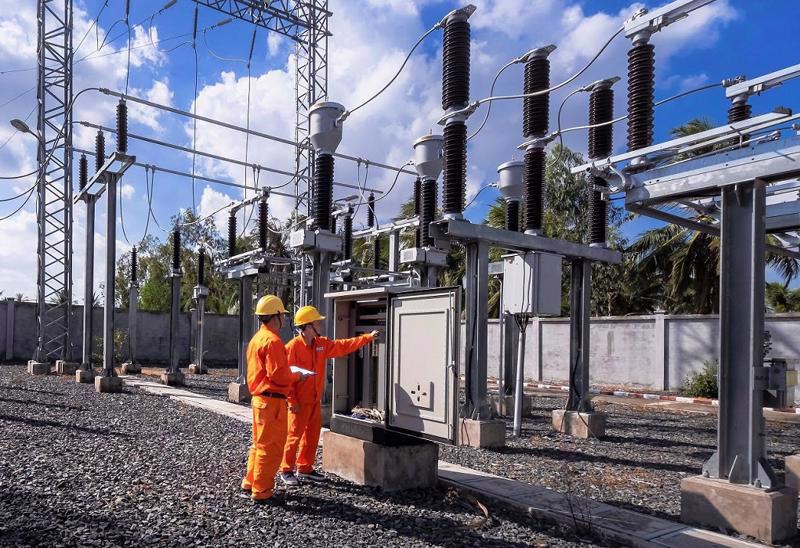The National Assembly (NA) has set an ambitious goal of 8 per cent economic growth in 2025 and double-digit growth from 2026 to 2030. To realize this vision, a key driving force will be energy, particularly electricity and sustainable, green energy sources. The Vietnam Economic Association (VEA) and the Vietnam Clean Energy Association, in partnership with Vietnam Economic Times / VnEconomy / Tap chi Kinh te Viet Nam, recently organized the Vietnam Energy Forum 2025, with the theme “Green and Clean Energy Towards a New Economic Era: Solutions to Promote the Development of New Energy Sources in Vietnam.” The event sparked meaningful discussions about the existing energy landscape and the exciting potential of renewable, green, and clean energy for Vietnam’s future.
‘Lifeblood’ of the economy
In his opening address, Dr. Chu Van Lam, Permanent Vice President of the VEA and Chairman of the Editorial Board at Vietnam Economic Times, emphasized the urgency of developing renewable, green, and clean energy. To meet economic growth targets of over 8 per cent in 2025 and strive for double-digit growth during the period from 2026 onwards, and to respond to strategic changes in operational methods, which include education, labor, and production, primarily based on digital platforms, it is essential to adjust and plan the necessary resources more effectively. One of the most fundamental and vital resources is electricity and green, clean energy sources. To meet urgent development goals, the demand for electricity has been calculated by management agencies and experts as increasing by 12-16 per cent annually.
From a practical perspective, especially the need for electricity to support economic development, the Party, State, NA, and government have paid significant attention in recent years to developing energy sources. This is reflected in strategic orientation documents such as Politburo Resolution No. 55-NQ/TW, issued on February 11, 2020, which outlines Vietnam’s National Energy Development Strategy to 2030 with a Vision to 2045.
On May 15, 2023, the Prime Minister issued Decision No. 500/QD-TTg, approving the National Power Development Plan for 2021-2030, with a Vision for 2050 (PDP8). The plan outlines specific directions for developing energy sources, particularly prioritizing the development of renewable, green, and clean energy.
In particular, in the context of needing acceleration and breakthroughs to propel the country into a “New Era - The era of the nation’s rise”, on November 25, 2024, the 13th Central Committee of the Communist Party of Vietnam agreed to restart the Ninh Thuan Nuclear Power Project in the south-central region and continue researching Vietnam’s nuclear energy program to ensure national energy security, meet socio-economic development goals, enhance scientific and technological capacity, and contribute to sustainable national development.
Furthermore, on November 30, 2024, during the 8th session of the 15th National Assembly, the NA officially passed the amended Law on Electricity, replacing the Law on Electricity 2004. The Law on Electricity 2024, effective from February 1, 2025, is expected to resolve existing difficulties and obstacles in the power industry, ensure electricity energy security, aim for net-zero emissions, and contribute to the sustainable and efficient development of the electricity sector, ensuring sufficient electricity supply for socio-economic development and people’s daily life.
Most recently, on March 3, 2025, the government issued Decree No. 58/2025/ND-CP, providing detailed regulations on several provisions of the Law on Electricity related to the development of renewable and new energy. This Decree is an important step in promoting sustainable development in the electricity sector, ensuring energy security, and minimizing environmental impact. It also serves as a positive signal for investors in the renewable energy sector in Vietnam.
Challenges and strategic directions
While numerous mechanisms and policies have been introduced, discussions at the recent Forum highlighted that the development of renewable, green, and clean energy in Vietnam is currently facing significant challenges. Mr. Nguyen Anh Tuan, Vice President and General Secretary of the Vietnam Energy Association, pointed out the real risk of an electricity shortage between 2026 and 2028. This concern arises from the slow pace of electricity generation, coupled with the stagnation in the expansion of renewable energy sources.
Mr. Tuan highlighted four reasons behind this. First, the slow implementation of plans. Second, the delayed resolution of projects continues to be an issue. Third, while offshore wind energy regulations have become clearer, they remain insufficient for effective deployment. As a result, no offshore wind projects have been launched as yet, threatening the target of reaching 6,000 MW by 2030. Finally, although there is a direction to transition from coal-fired thermal power to gas-fired power, progress has been slow.
To address these obstacles in developing renewable and clean energy, on December 31, 2024, the Prime Minister issued Decision No. 1710/QD-TTg approving the task of adjusting the PDP8.
On February 19, 2025, the Council for Appraisal of the Adjustment of PDP8 unanimously approved the adjusted plan. This outlines an additional 27,747-80,819 MW of electricity generation capacity, up from the original PDP8. Notably, the adjusted plan includes the addition of the Ninh Thuan 1 and 2 Nuclear Power Plants, with a total capacity of 6,000-6,400 MW, expected to be operational between 2030 and 2035. The system will need to add approximately 4,500-5,000 MW of nuclear power in the north and around 3,000 MW in the central region by 2050, mostly in the form of small modular reactors (SMR) to provide base load power for the system.
Mr. Tuan emphasized that the adjusted PDP8 significantly increases the scale of solar and wind energy capacity, presenting a promising opportunity for investors. The pricing of electricity will vary by region, reflecting the investment signals and production costs. The draft also introduces significant expansion of pumped storage hydropower, battery storage, and flexible power sources. This opens up ample investment opportunities in new services like ancillary services for the power system and the production of new fuels, such as green hydrogen and ammonia.
To accelerate implementation, Mr. Tuan recommended quickly finalizing regulatory documents, including the amended Law on Atomic Energy and the Law on Energy Efficiency and Conservation. For subordinate documents, regulations on flexible power source pricing, pumped storage hydropower pricing, and the development of renewable and new energy sources should be issued to support their growth.
Experts attending the forum agreed that Vietnam is at a critical juncture with a major opportunity to develop green and clean energy, ensuring energy security and sustainable development. However, to successfully achieve this goal, close collaboration between the government, businesses, citizens, and professional associations is essential. With strong political will, coordinated action across ministries, and active private sector involvement both domestically and internationally, renewable and new energy will become a solid foundation, driving economic and social growth in the new era while aligning with sustainable development.
1. Total power capacity according to the adjusted PDP8 approved by the Council for Appraisal of the Adjustment of the PDP8
The total power capacity to meet domestic demand by 2030 (excluding exports, co-generation, and risky thermal power) is 183,291-236,363 MW. This includes:
- Thermal power from coal: 31,055 MW (16.9-13.1%);
- Thermal power using domestic gas: 10,861 MW (5.9-4.6%);
- Thermal power using imported LNG: 8,824 MW (4.8-3.7%); and
- Hydropower: 33,294-34,667 MW (18.2-14.7%);
For renewable energy, biomass, waste-to-energy, geothermal power, storage, and flexible power sources:
- Onshore wind power: 27,791-28,058 MW (13.2-14.4%);
- Solar power (including concentrated solar power and rooftop solar): 46,459-73,416 MW (25.3-31.1%);
- Biomass, waste-to-energy, and geothermal power: 2,979-4,881 MW (1.6-2.1%);
- Energy storage: 12,394-22,271 MW (6.8-9.4%); and
- Flexible power: 2,000-3,000 MW (1.1-1.3%);
Regarding electricity imports, exports, and nuclear power development:
- Imported power: 9,360 MW (5.1-4.0% of total power capacity);
- Projected electricity exports: 5,000-10,000 MW; and
- Nuclear power: 6,000-6,400 MW, to be operational in 2030-2035;
2. Total installed power capacity by 2050, under the adjusted PDP8
- Nuclear power: 9,800 MW (1.2% of total power capacity);
- Thermal power from coal: 0 MW;
- Other thermal power: 124,374 MW (14.6% of total power capacity), including combined-cycle gas turbines domestic gas, LNG conversion new LNG combined-cycle gas turbines flexible power sources;
- Biomass, waste, and other energy sources: 6,364 MW (0.7% of total power capacity);
- Hydropower: 37,154 MW (4.4% of total power capacity);
- Onshore and nearshore wind power: 96,645 MW (11.3% of total power capacity);
- Offshore wind power: 138,639 MW (16.3% of total power capacity);
- Concentrated solar power: 157,976 MW (18.5% of total power capacity);
- Rooftop solar power: 98,620 MW (16.2% of total power capacity);
- Pumped storage hydropower and battery storage: 112,769 MW (13.2% of total power capacity); and
- Imports: 30,391 MW (3.6% of total power capacity);









 Google translate
Google translate